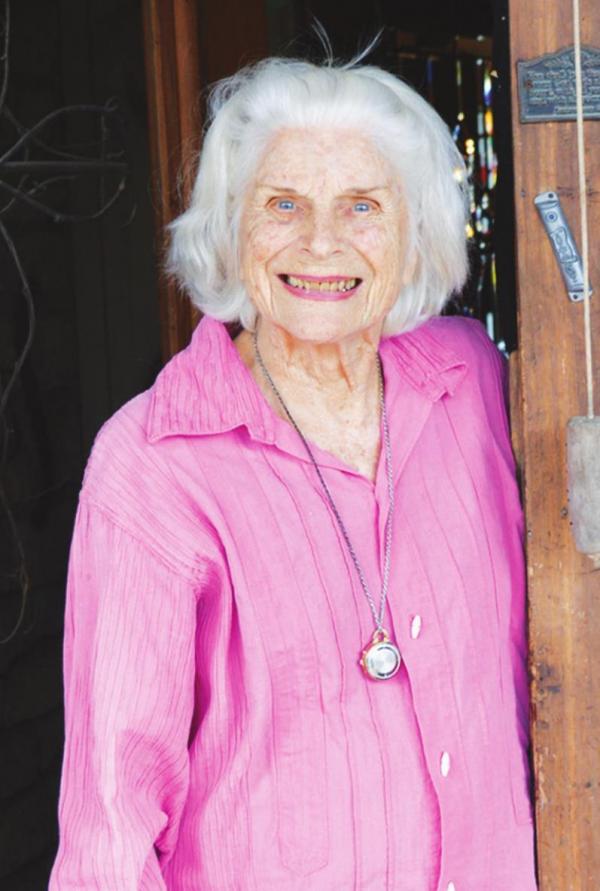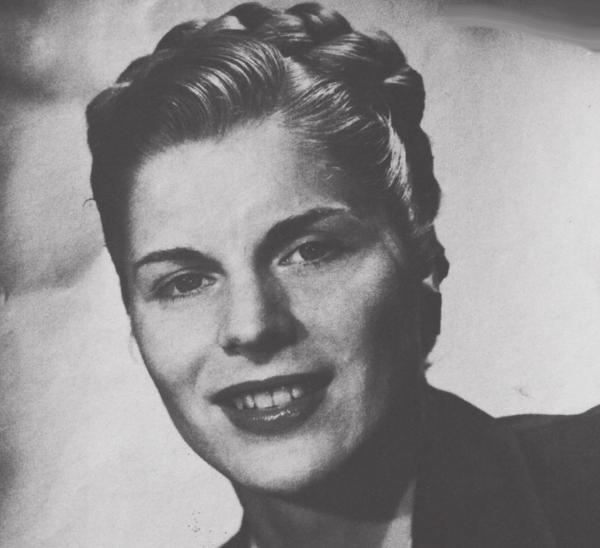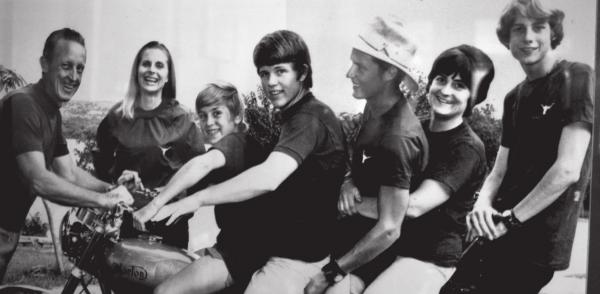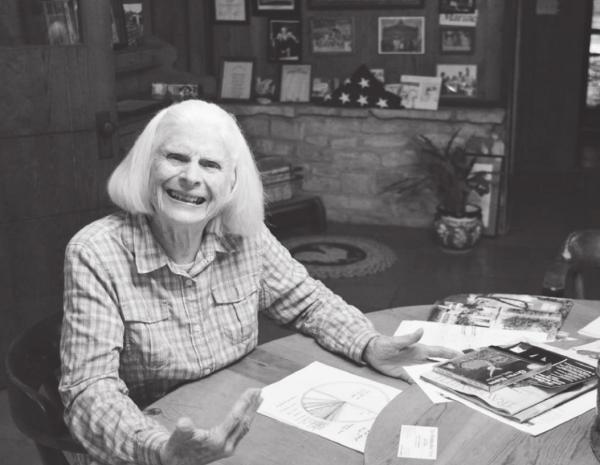A matriarch of Wimberley passes on
This article was originally written in February of 2019. After having the story read to her before publication, MF Johnson said it was the story of her life. She asked that we wait to publish it until she was gone. It is printed here now to honor both her wishes and her life.
As she had done hundreds, perhaps thousands of times before, MF Johnson sat at the banks of Cypress Creek overlooking Blue Hole. From the seat of her golf cart, she reminisced about her time here in Wimberley, her family and her love of community.
The first glimpse Mary Frances Brown, known by most these days as MF, ever took of the Wimberley Valley was along Ranch Road 12. Coming from San Marcos, about where the roadside park is atop the hill, she looked out the window of the 1935 Ford she was riding in. She was in the car with Bill Johnson and one of Bill’s Marine buddies.
It was just after the war. Bill knew the area well with his family’s Sabino Ranch located alongside Cypress Creek. Bill had borrowed his grandfather’s car. As it reached the top of the hill MF was overcome with the beauty of the valley, what she would later call “God’s spot.”
“I said, ‘Stop this car, I’m getting out and never leaving,’” MF said. “We came in from San Marcos. Bill Johnson had called and said, ‘I have a fellow Marine, and we’re going to Wimberley. Have you ever been there? Want to come?’”
This was her first visit to the valley where she would spend much of the rest of her life.
At the time, MF and Bill were both students at the University of Texas at Austin. Atop that hill on the edge of the Wimberley Valley, Bill did exactly what he was asked to do. He let MF out of the car – and then he drove off. He returned about 10 minutes later, but MF had already left. The lighthearted moment was one that sparked a friendship that would literally last a lifetime.
“You can only have one best friend, right?” MF said with a twinkle in her eye.
MF Brown became MF Johnson. And the lasting marriage produced five children. “Four who have moved back into the area I might add,” she said.
BEAUTIFUL ENOUGH TO FLY
Born June 5, 1924 in Indianapolis, Indiana as an only child, her family moved about every five years. First to Detroit then eventually to Tulsa, Houston and Dallas.
Both her stepfather and her mother were certified pilots. Her stepfather, from Brooklyn, N.Y. was an aviation pioneer, building his first glider at 13 before he sold another at 15. Spartan Aircraft was his business.
During the Depression, the aircraft industry was hard hit. They moved to Tulsa as the family had a house there.
She remembered “Nice house, little furniture. They were lean times. I was an only child, always the new girl, never made friends.”
“Then one day my stepfather said we were moving to Texas, and I said where is that?” She attended high school for a year and a half in Houston then onto the Dallas area. They were off to Garland, “Where the airplane factory was next to a pickle factory.”
At 15 she was driving and had a car to run errands for the family. “I got a ticket in Dallas and was outraged, outraged.” She gave the policeman a piece of her mind. At 16, and still in high school, she decided she also wanted to be a pilot. She worked as a model part-time to earn money for flight lessons, and the lessons were the only thing on her mind. She was able to skip her Spanish language course to make time for the additional workload. While many idolize the glitz and glamor of a modeling job, MF looked on it as being just a “clothes hanger. I’ve said that all my life.”
Photographs of MF were used in national magazines, including the cover of “Mademoiselle” with commercial ads in numerous fashion magazines. “Living near Dallas helped a lot fashion-wise.” At the time, Dallas was making a bid to become a third fashion center like New York and Los Angeles.
“It was ridiculous… The Braniff (Airways) campaign where a lot of money was spent. They could’ve put the clothes on anybody… The models were 16 to 19 years old. I only made the money to fly.”
She was able to now pay for flying lessons, but there was a problem. The instructor would not let her fly solo without parental consent. Talking with MF’s mother on the phone, her mother gave the instructor about ten more steps he had to accomplish before she gave her permission. Knowing all about airplanes herself, mother knew best. She finally got the permission, and MF received her pilot’s license.
The war began, the Depression was over and her parents worked around the clock at the factory… She would see her mother in the morning when she would spend time with MF and would braid her hair. “Otherwise, I wouldn’t see my mother and the time was precious to me.” She continued. “When my hair got longer, that was the best time.” Then her senior year hit and WWII began.
COLLEGE AND MEETING THE LOVE OF A LIFETIME
“We were at war… The factories slowly turned with women leaving the kitchen taking over jobs usually held by men who went off to war… It was a wonderful generation to be a part of… What a difference that war was from now.” She graduated from Highland Park High School in 1942.
After high school it was off to UT at Austin and getting a degree in radio. The plan was to go to New York City for a career in media. Taking her studies very seriously, she became a radio editor for UT’s radio station. She was assigned to interview the returning veterans from Iwo Jima where she met the captain of the UT Swim team. “Then one day, Bill was sitting on the top step. He was finishing up his degree, back from Iwo Jima.” Getting acquainted and becoming friends was off and running.
Bill’s grandfather, a Confederate veteran was originally from Georgia, brought his sisters and widow mother to San Marcos where his late father bought land, originally along Cypress Creek near town. Sabino Ranch was also a retreat for Bill’s father, Parks Johnson, a nationally known radio host of “Vox Pop,” a popular radio show of the 1930s and 40s.
Although Bill went to high school in New York, he learned to swim at Blue Hole and after graduation returned to Texas to attend UT nearby.
Bill was UT’s Swim Captain, both before the war and also again when he returned. The UT Swim team would be a pretty significant part of their lives, with Bill’s friendship with Coach Tex Robertson and both MF and Bill being an integral part of Camp Longhorn.
MOVING TO WIMBERLEY
MF and Bill were married on June 5, 1947. She was 23 and he was 24. “In 1947, it (Wimberley) was only a wide spot in the road. There were about 500 people in Wimberley. There was a small grocery, small convenience-type store that sold Western boots.” It was there she met Governor Allan Shivers, Texas Governor in the 40s and 50s. Wimberley was a well-kept secret then, “but there were a lot of bigwigs that knew.” It was special.
“Wimberley was such a joy. Every spring, we (the community) would go out and pick up the trash because the summer visitors would be coming. Then when we got phones, and party lines. We’d call a friend… and then we would pick up trash and have a social meeting at the same time.”
She continued. “When on the ranch, there was seldom the need to be in town, although we were only a half mile from the Square,” she said laughing. “There were no phones until later. The post office was on the Square at the time. We spent lots of time at Blue Hole. All of our children learned to swim at Blue Hole.”
In order to make money MF wrote a column for the San Marcos Daily Record. “I’d gather up the children and tell them, ‘Get your toys,’ I was leaving in five minutes. They’d be in the back of the car with a blanket, and off we would go to interview people.” She also got to learn the names of everyone in town. It is where her deep love of the valley grew.
“After moving every five years, this is my spot. I’m never going to leave.”
They were farming in San Marcos and ranching by the banks of Blue Hole from 1947 to 57. The war was over, they were married with births and more children on the way and then life dealt another twist.
LEAVING WIMBERLEY
“I was an outsider (to Wimberley) twice.”
The great drought of the 50’s hit hard. “First the crops died, then the animals… We were with four kids and no rain. There went the cows and goats, and there we went.” They left the valley. “I had a bucket of tears out there when Bill told me we were leaving. As my tears welled up, Bill said that we would probably be gone five years. And then we went to Camp Longhorn near Burnet.”
Tex Robertson, the UT Swim coach, founded the camp and called upon Bill to help. As captain of the swim team twice, before and after WWII, the close ties with Tex helped to make Camp Longhorn successful.
“Bill knew Tex better than his father.”
While working at Camp Longhorn, they would make the trip back to Wimberley to check on things at the ranch and Bill’s parents had retired here. At the camp, Bill and MF did everything that was needed. Being the journalist she had been, she started a camp newspaper.
“(We would) pick out the shyest boy in each cabin and make them the reporter for the cabin. Later Tex wanted to do an annual, with every camper getting one.” There was a “Merit Store” where the only way to buy anything was with merits earned for things such as good behavior. The camp counselors gave out the merits as well as demerits.
“You wrote checks with merits, just like money. They learned how to write checks. If bad behavior improved, you’d get what you’d want with merits.”
Those five years turned into 25 years. The Johnsons were integral in the success of Camp Longhorn, which continues to this day with three separate camps. But finally the drought broke and they returned to Wimberley.
BACK IN TOWN FOR GOOD
“We got back here and (were) newcomers again.”
The population was about 1,500 to 2,000 people… “(We came) to care for his mother. That’s the reason we came back. It was time to go back (to Wimberley and) for Bill to go back to ranching and farming.”
MF was once again ready to get involved and her hands touched many of the civic facilities that are around today. She was part of the creation of the Crisis Bread Basket and took over some of her family’s desires to have a seniors center in town. She was a long term board member and multiple past president of the Wimberley Seniors Citizens Activities Inc.
“My project was having a place in the center of town where you could have a picnic. It was my full time job… ‘First the dirt’ was my campaign slogan around town,” MF said as she set out to raise funds to purchase the land necessary.
The campaign to raise money for the project was on, and in 1986 they bought the Old Church Hall for a Senior Center and the Thrift Shoppe was built near the corner of Ranch Road 12 and River Road.
In 1991, when 1.85 acres close to the Senior Center became available, WSCAI again solicited community donations. That area is now the Wimberley Valley Chamber of Commerce and Visitor’s Center. Then the Winter-Wimberley House and land became available.
“But what will happen to that land if we don’t buy it,” MF remembered everyone wanting to get involved to purchase the land.
There were a few delays, but soon money would be raised to purchase the land. To show the amount of donations raised, a sign with a picture of a thermometer was installed near the site.
MF remembered climbing the ladder to paint the “temperature” a little higher as more money was raised and the excitement when donations came in. The campaign was soon successful, the lands were purchased and this historical site preserved for future generations.
WSCAI then raised $750,000 for the Wimberley Community Center and approached what was the newly incorporated city of Wimberley to help solicit grants from the state of Texas to complete the project. MF was on the committee that helped design and manage the creation of the Community Center. When the funds were raised and the construction completed, the main hall of the community center was named Johnson Hall in honor of her and her family’s efforts towards the project over multiple decades.
While her talent, and tenacity, for fundraising helped pay for many of the town’s civic facilities, her volunteer spirit was also an example set for what she called “The Wimberley Way.”
“It is so lovely, the town of Wimberley. It was so special, people volunteering, with an emphasis on community. People cared about where they were. It wasn’t even a town, a village until 2000. And now it is a magnet for people in many states… What a privilege to live in God’s spot.”
Sitting by the banks of the creek in her golf cart, she reiterated how the land is “a God spot” with the ancient cypress by the creek. Relating what Bill came home to after the war and how much they both loved the land.
“I have five kids, one died, but the children were raised here and now they have come back… It’s so wonderful about the land,” she said.
For a woman who had moved so many times in her life, yet spent so many years in the same place, MF had found home. She looked out over the water that her children and generations before had learned to swim in. Even in the cold February air, Cypress Creek was beautiful. It is no wonder why she loved the land. Then she started her golf cart and headed back to the house.





